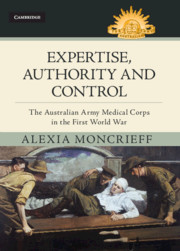Book contents
- Expertise, Authority and Control
- Other titles in the Australian Army History Series
- Expertise, Authority and Control
- Copyright page
- Contents
- Figures, maps and tables
- Preface
- Acknowledgements
- Note on style
- Abbreviations
- Introduction
- Chapter 1 Gallipoli
- Chapter 2 Medicine in the lines
- Chapter 3 The Western Front in 1918
- Chapter 4 A pleasant dose of medicine?
- Chapter 5 The most difficult problem
- Conclusion
- Notes
- Bibliography
- Index
Chapter 5 - The most difficult problem
Preventing and treating venereal disease
Published online by Cambridge University Press: 10 February 2020
- Expertise, Authority and Control
- Other titles in the Australian Army History Series
- Expertise, Authority and Control
- Copyright page
- Contents
- Figures, maps and tables
- Preface
- Acknowledgements
- Note on style
- Abbreviations
- Introduction
- Chapter 1 Gallipoli
- Chapter 2 Medicine in the lines
- Chapter 3 The Western Front in 1918
- Chapter 4 A pleasant dose of medicine?
- Chapter 5 The most difficult problem
- Conclusion
- Notes
- Bibliography
- Index
Summary
In 1915, four months after the first convoy of Australian soldiers disembarked in Egypt, venereal disease (VD) infected roughly 10 per cent of the Australian Imperial Force (AIF).1 In the Official History, Butler described it as ‘a startling outburst’ that resulted in 3 per cent of the force being ‘constantly sick’.2 Given that a significant number of soldiers were not only incapacitated but also occupying hospital beds that would be needed once combat casualties started to arrive, VD had serious implications for the efficiency of the AIF and its medical services.
Keywords
- Type
- Chapter
- Information
- Expertise, Authority and ControlThe Australian Army Medical Corps in the First World War, pp. 141 - 178Publisher: Cambridge University PressPrint publication year: 2020

